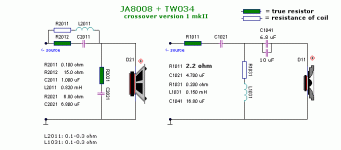I have a pr of Technicoustic 8 inch woofers and a pr of d25 tweeters.
I want to build a sloped baffle cabinet and have figured the dimentions using winIs software.
36" high
12" wide
12.5 deep at the bottom
7" deep at the top
3" wide 5" long port
Gives me flat to 40, -3db at 33
My question, should I use a first or second order design? I can place the drivers so the coils are aligned.
I want to crossover at 2500hz
Sudgetsions on inside damping are welcome, I want to use 3/4" 7 layer birch (this way no need to veneer)
Woofer specs
Fs= 41.8514 Hz
> Qms= 4.0187
> Qes= 0.4916
> Qts= 0.4380
> Vas= 1.2886
> Sens= 89.1973 1W/1m
> Sens= 92.8913 2.83 V/1m
> Bl= 6.5687
> Revc= 3.4174 Ohm
Thanks
Bob
I want to build a sloped baffle cabinet and have figured the dimentions using winIs software.
36" high
12" wide
12.5 deep at the bottom
7" deep at the top
3" wide 5" long port
Gives me flat to 40, -3db at 33
My question, should I use a first or second order design? I can place the drivers so the coils are aligned.
I want to crossover at 2500hz
Sudgetsions on inside damping are welcome, I want to use 3/4" 7 layer birch (this way no need to veneer)
Woofer specs
Fs= 41.8514 Hz
> Qms= 4.0187
> Qes= 0.4916
> Qts= 0.4380
> Vas= 1.2886
> Sens= 89.1973 1W/1m
> Sens= 92.8913 2.83 V/1m
> Bl= 6.5687
> Revc= 3.4174 Ohm
Thanks
Bob
It depends on the individual drivers responses (off axis meas., breakup modes, other nasties, and well many others things) and the preference of the Xover designer. My desiqns are symetrical acoustically but not electrically.
edit> sorry no specific guidance here, as I don't have knowledge of your drivers, links?
edit> sorry no specific guidance here, as I don't have knowledge of your drivers, links?
Are you talking 1st order electrical or first order acoustic? First order acoustic is very hard to acheive and usually results in a very complex XO. Not to mention that I don't know of any 8" that will work well with a 1st order acoustic slope at 2500 Hz. Most 5" drivers don't have extended enough response into the stop band for proper 1st order acoustic slopes.
With an 8" woofer, I would cross over as low and as steep as possible but without seeing the measured response of your woofer, it is hard to say how low but probably at least 2000 Hz and 4th order acoustic slopes.
Regards,
Dennis
With an 8" woofer, I would cross over as low and as steep as possible but without seeing the measured response of your woofer, it is hard to say how low but probably at least 2000 Hz and 4th order acoustic slopes.
Regards,
Dennis
I'm in a little over my head here, but to make a judgment, I would need to see a frequency response graph for each of the speakers. That would tell me more than the technical specs at this stage.
So, if possible give us the exact brand and model numbers of each speaker, and hope against all hope, that might lead us to a sample frequency response graph.
You can want a 2500hz crossover, and on general principle a 2500hz crossover might be a good one, but we can't say it is good for the speakers in question until we know more about them. Rated frequency response almost always falls short of real, practical, workable frequency response.
Also, where you are in the workable frequency band make a difference. If the functional low end of your tweeter is 2500hz, then likely you need a sharp steep crossover if you want to maintain the power rating. On the other hand, if the tweeter goes down to 1500hz, and you crossover at 2500hz, then you could probably use a shallower slope.
If you can't get at sample frequency response graph for each speaker, then you will likely have to test the speakers, and make a judgment based on the results.
Steve/bluewizard
So, if possible give us the exact brand and model numbers of each speaker, and hope against all hope, that might lead us to a sample frequency response graph.
You can want a 2500hz crossover, and on general principle a 2500hz crossover might be a good one, but we can't say it is good for the speakers in question until we know more about them. Rated frequency response almost always falls short of real, practical, workable frequency response.
Also, where you are in the workable frequency band make a difference. If the functional low end of your tweeter is 2500hz, then likely you need a sharp steep crossover if you want to maintain the power rating. On the other hand, if the tweeter goes down to 1500hz, and you crossover at 2500hz, then you could probably use a shallower slope.
If you can't get at sample frequency response graph for each speaker, then you will likely have to test the speakers, and make a judgment based on the results.
Steve/bluewizard
- Status
- This old topic is closed. If you want to reopen this topic, contact a moderator using the "Report Post" button.
